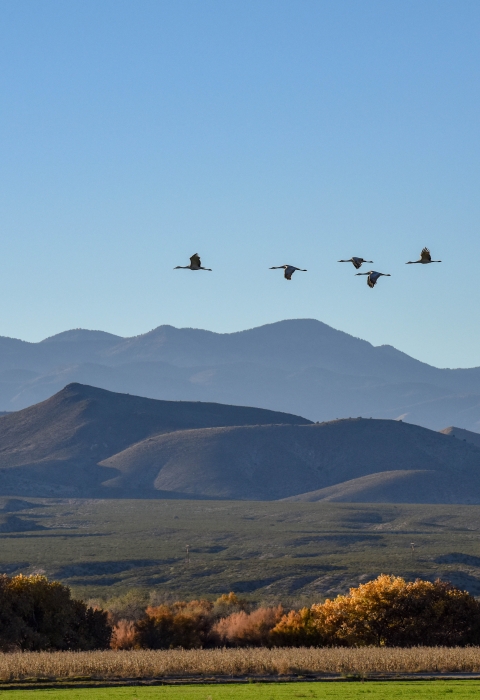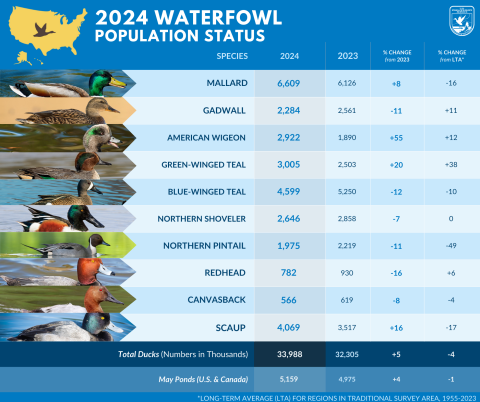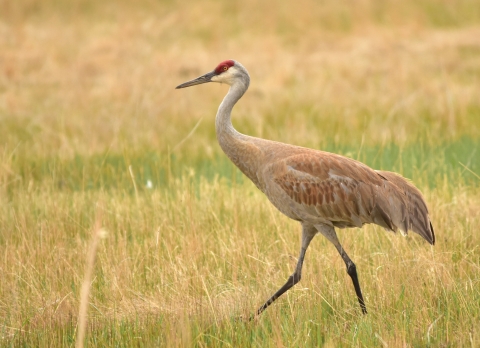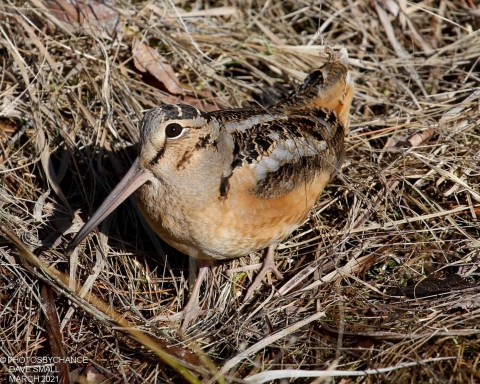Quality scientific data serve as the foundation for future conservation actions and successful wildlife management. With this in mind, our Migratory Bird Program Division of Migratory Bird Management coordinates and conducts numerous surveys to gather essential population status and hunting activity data for migratory bird species across North America each year. While some surveys cover multiple species over vast regions, others focus on a single species in small geographic areas. This monumental effort in species monitoring involves a tremendous amount of data management to ensure data quality and accessibility. The information gained is valuable data that we then synthesize and summarize into annual status reports, posted here and disseminated to partners each August.
These reports aren't just numbers and facts; they're living narratives that resonate with our many partners in conservation, from hunters to researchers and bird enthusiasts alike. Data from these surveys provide invaluable information on migratory bird population abundance, distribution, and trends, which is used to stay current on a wide variety of conservation plans, adaptive harvest management strategies, hunting regulations, and other publications throughout the year. Collecting and synthesizing such information on a yearly basis provides us and our partners with a historical, long-term perspective in migratory bird population changes over time that ultimately allows us to make more informed decisions to conserve and manage migratory bird populations for future generations.
This continuously growing record of historic migratory bird data is made possible through partnership and cooperation between the U.S. Fish and Wildlife Service (FWS), Canadian Wildlife Service (CWS), various state and provincial agencies, and private conservation organizations across the continent.
Population Status Reports
Waterfowl Population Status
2024 Waterfowl Population Status Report
Our agency has been collecting data on waterfowl populations through annual surveys for nearly 80 years, making it the most robust dataset we have for any species group to-date!
These surveys have allowed us to see that, unlike any other bird group, almost all waterfowl populations have actually increased over the years. Such waterfowl conservation success is a testament to the value of long-term species monitoring and the data collection that make these critical annual reports for effective conservation planning. The annual Waterfowl Population Status Report summarizes the most current data and estimates on the breeding population and habitat conditions of most North American duck species, several populations of geese, tundra swans, and American coot. Annual status of these populations is monitored and assessed via a combination of aerial and ground crew surveys across 2 million square miles.
Among these surveys is the historic Waterfowl Breeding Population and Habitat Survey (WBPHS) (Also known as Breeding Population Survey [B-POP] or the May Survey), which has evolved into the largest and longest running wildlife survey in the world! For WBPHS, teams of specially trained pilot biologists take flight each May and June in collaboration with the Canadian Wildlife Service. They count waterfowl and assess the quality and quantity of waterfowl breeding habitat from the wide-open bays and wetlands of the eastern shores of North America to some of the most remote regions of Alaska and Canada. Data is also obtained from the Mid-winter Survey (Each December/January in wintering areas), the Yukon-Kuskokwim Delta Aerial Breeding Pair Survey, the Arctic Coastal Plain Aerial Breeding Pair Survey, and surveys specifically designed for goose populations. Insights gained from these surveys are vitally important to the management of waterfowl across North America and are used to set waterfowl hunting regulations for the following years.
NEW! Update on the Northern Pintail Harvest Strategy
First-hand field reports from Pilot Biologists: WBPHS Field Reports Library Collection.
For WBPHS data or historical documents, including older population status reports not included in the Waterfowl Population Status Report Library Collection, please visit ServCat Program Record # 47314.
Sandhill Crane
2024 Status and Harvests of Sandhill Cranes
North American sandhill cranes are collectively the most abundant of the world's crane species. We survey four populations of sandhill cranes each year to estimate breeding population size: the Mid-Continent Population (MCP), in the High Plains U.S.; the Rocky Mountain Population (RMP), in the western U.S.; the Lower Colorado River Valley Population (LCRVP), primarily in northeast Nevada, and the Eastern Population (EP) in the Great Lake, Mid-Atlantic and Southeastern states. These populations are monitored through breeding and pre-migration surveys to provide information for harvest management. For the MCP, extensive, spring aerial surveys on major concentration areas that are corrected for observer visibility bias provide annual indices of abundance used to measure population trends. These surveys are conducted in late March, at a time when birds that wintered in Mexico, Arizona, New Mexico, and Texas usually have migrated northward to spring staging areas, but before spring "break-up" conditions allow cranes to move into Canada. A fall pre-migration survey is conducted by 5 states (UT, CO, ID, WY, and MT) for the RMP, to avoid counting cranes from other populations that comingle during the spring breeding period. The LCRVP is surveyed in winter by airplane at four major wintering areas in Arizona and California. The EP is surveyed by volunteers and agency personnel at staging areas in the fall to count cranes migrating from Canada. Results from these efforts are summarized in this report to provide annual population status, recruitment indices, harvest trends, and other management information.
- Sandhill Crane Population Status Report Library Collection
- Eastern Population of Greater Sandhill Crane Fall Survey Report Library Collection
- USFWS Eastern Population Sandhill Crane Data Portal - Survey description and an interactive observations map
- Coordinated Survey for Mid-Continent Population Sandhill Crane Reports Library Collection
- Rocky Mountain Population of Greater Sandhill Crane Survey Reports Library Collection
- Lower Colorado River Valley Population - Abundance indices can be found within the most recent Pacific Flyway data book
Band-tailed Pigeon
2024 Band-tailed Pigeon Population Status
Band-tailed pigeons are managed collaboratively by state and provincial wildlife agencies, along with the U.S. Fish and Wildlife Service and the Canadian Wildlife Service, all adhering population-specific management plans for both the Pacific Coast and Interior regions. Each year, surveys of band-tailed pigeons are conducted by biologists across the western United States and British Columbia to monitor annual population status. The Breeding Bird Survey has provided an annual index to the abundance of both Pacific Coast and Interior band-tailed pigeons since 1968, and the Mineral Site Survey (MSS) has been used to track the abundance of Pacific Coast band-tailed pigeons since 2004. The MSS involves a visual count of band-tailed pigeons at select mineral sites throughout the population's range. Hunter participants are drawn from the Harvest Information Program (HIP) to provide data on estimates of harvest. Through the Parts Collection Survey, active band-tailed pigeon hunters are selected from HIP to provide detailed information on the sex and age composition of the harvest. These methods enable the calculation of annual indices of abundance across states, provinces, and regions. This report summarizes such information on the abundance and harvest of band-tailed pigeons in the western United States and British Columbia. The resulting information is then used to help guide management decisions and to establish band-tailed pigeon hunting regulations for the upcoming season. Band-tailed Pigeon Population Status Report Library Collection
Mourning Dove
2024 Mourning Dove Population Status
Maintenance of healthy, productive mourning dove populations, one of North America's most abundant and familiar species, remains a primary management goal. This report summarizes the latest data on mourning dove populations survival, recruitment, abundance and harvest in the United States across three management units: Eastern, Central and Western. Trends in the number of doves heard and seen per route from the all-bird National Breeding Bird Survey (BBS) are reported and contribute to estimates of abundance and survival. Recruitment and harvest data are collected from the Mourning Dove Parts Collection Survey, Hunter Diary Survey and national Mourning Dove Banding Program. Together, the data collected from these monitoring programs provide comprehensive information for understanding trends in abundance, recruitment, harvest impacts, and overall mourning dove population biology. The resulting report is vital for developing adaptive management strategies and informing mourning dove hunting regulation decisions.
American Woodcock
2024 American Woodcock Population Status
The American woodcock, a unique game bird of eastern North America, is popular among upland hunters and remains subject to dedicated conservation efforts involving in-depth population and harvest studies. This annual report provides a comprehensive look at the species population through data compiled by three key surveys: the Singing-ground Survey (SGS), and both the Harvest Information Program’s (HIP) Parts Collection Survey and Diary Survey. These detailed studies are tailored to overcome the challenges posed by American woodcock's elusive nature, marked by their cryptic coloration, small size, and affinity for dense vegetation. The report consolidates findings each June in order to guide managers in regulating the general harvest of this popular game bird and identify areas needing targeted management actions. It aligns with the Service’s goal of not only stabilizing American woodcock populations, but also restoring them back to levels observed in the early 1970s. By providing essential insights such as indices of abundance changes from SGS, annual recruitment indices from Wing Surveys, and harvest estimations from HIP, the report forms a crucial instrument for robust and comprehensive management, affirming the necessity of coordinated efforts to ensure the species' sustained presence. American Woodcock Population Status Report Library Collection
Population Status Report Library Collection
All Population Status Reports can also be found in the Population Status Library Collection, including status reports on peregrine falcon and bald and golden eagles, though they are not published annually.
These ongoing efforts in large-scale migratory bird monitoring and data management are made possible through the collaboration of many partners and hundreds of dedicated individuals each year. These results reflect the commitment and mission of FWS to work with others to protect, restore and conserve bird populations and their habitats for the benefit of future generations by: ensuring long-term ecological sustainability of all migratory bird populations, increasing socioeconomic benefits derived from birds, improving hunting and bird watching and other outdoor bird-related experiences, and increasing awareness of the value of migratory birds and their habitats for their aesthetic, ecological, recreational and economic significance.
Migratory Bird Hunting Activity & Harvest Reports
Migratory Bird Hunting Activity & Harvest Report (2023-2024)
These reports present hunter activity and harvest estimates from the Migratory Bird Harvest Information Program (HIP), a cooperative State-Federal program that requires all hunters to complete a questionnaire when registering for a hunting license each year and in each state in which they hunt. States are responsible for collecting and forwarding us responses from each migratory bird hunter, which involve a series of general screening questions about their hunting success the previous year. A smaller sample of hunters based on HIP responses are then sent the Migratory Bird Hunter/Harvest Survey (Diary Survey) and the Parts Collection Survey (Wing Survey). Hunters selected for the Diary Survey are invited to take the online survey which asks for the date, county, and number of birds taken for every hunt. Diary Survey information gives us harvest estimates for the following species or species groups: 1) doves and band-tailed pigeons, 2) waterfowl (ducks, sea ducks, geese, and brant), 3) American woodcock, 4) rails, gallinules, coots, snipe, and 5) sandhill cranes. A sample of hunters from the Diary Survey are then asked to send parts from the birds they harvested for the three independent Wing Surveys: (1) waterfowl, (2) mourning dove, and (3) woodcock, rail & band-tailed pigeon. Biologists at “wingbee” events examine wings collected to determine each birds’ species, age, and sex. Woodcock wings can help us determine their age and sex ratios. Mourning dove and band-tailed pigeon wings can help us determine their age ratios. Rail wings can help us determine their species. Data on age ratios can also help to calculate reproduction rates, which play an important role in keeping migratory bird populations stable. The FWS is responsible for reporting estimates of the harvest of each species or species group, the number of days hunted, the number of active hunters, and the number of birds bagged per hunter in each state for which there is a hunting season for that species or species group.
Various partners reference the harvest numbers, hunter effort, and other metrics found in this report throughout the year, especially when answering public inquiries regarding potential changes in hunting seasons or bag limits. Migratory Bird Administrative Flyways also rely on information from these reports for presentations to constituent groups, in prioritizing conservation efforts, and in the Adaptive Harvest Management process of setting annual hunting regulations.
Migratory Bird Hunting Activity and Harvest Report Library Collection
Adaptive Harvest Management Reports
Annual Flyway Data Books
Migratory Bird Program Administrative Flyways also produce annual reports with data for each flyway (Atlantic, Mississippi, Central, and Pacific) that are distributed each Fall in Flyway-specific reports called "data books." These data books also include summaries of species- and population-specific abundances, harvests, and other important information derived from State-Federal Cooperative monitoring programs such as the Harvest Information Program, the Waterfowl Breeding Population and Habitat Survey, the Mid-winter Waterfowl Survey, and other surveys used to assess the status and harvests of hunted webbed and webless game birds.












